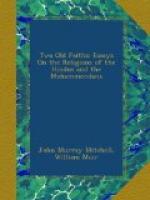[Sidenote: Growth of priestly power. Schools for the study of sacred books, rites, and traditions.] The Brahmanas are very poor, both in thought and expression. They have hardly their match in any literature for “pedantry and downright absurdity."[10] Poetical feeling and even religious feeling seem gone; all is dead and dry as dust. By this time the Sanskrit language had ceased to be generally understood. The original texts could hardly receive accessions; the most learned man could do little more than interpret, or perhaps misinterpret, them. The worshiper looked on; he worshiped now by proxy. Thus the priest had risen greatly in importance. He alone knew the sacred verses and the sacred rites. An error in the pronunciation of the mystic text might bring destruction on the worshiper; what could he do but lean upon the priest? The latter could say the prayers if he could not pray. All this worked powerfully for the elevation of the Brahmans, the “men of prayer;” they steadily grew into a class, a caste; and into this no one could enter who was not of priestly descent. Schools were now found necessary for the study of the sacred books, rites, and traditions. The importance which these attach to theology—doctrine—is very small; the externals of religion are all in all. The rites, in fact, now threw the very gods into the shade; every thing depended on their due performance. And thus the Hindu ritual gradually grew up into a stupendous system, the most elaborate, complex, and burdensome which the earth has seen.
[Sidenote: Moral character of the Veda.] It is time, however, to give a brief estimate of the moral character of the Veda. The first thing that strikes us is its inconsistency. Some hymns—especially those addressed to Varuna—rise as high as Gentile conceptions regarding deity ever rose; others—even in the Rig Veda—sink miserably low; and in the Atharva we find, “even in the lowest depth, a lower still.”
[Sidenote: Indra supersedes Varuna.] The character of Indra—who has displaced or overshadowed Varuna[11]—has no high attributes. He is “voracious;” his “inebriety is most intense;” he “dances with delight in battle.” His worshipers supply him abundantly with the drink he loves; and he supports them against their foes, ninety and more of whose cities he has destroyed. We do not know that these foes, the Dasyus, were morally worse than the intrusive Aryas, but the feelings of the latter toward the former were of unexampled ferocity. Here is one passage out of multitudes similar:
“Hurl thy hottest
thunder-bolt upon them! Uproot them! Cleave
them
asunder! O, Indra,
overpower, subdue, slay the demon! Pluck him up!
Cut him through the
middle! Crush his head!”




